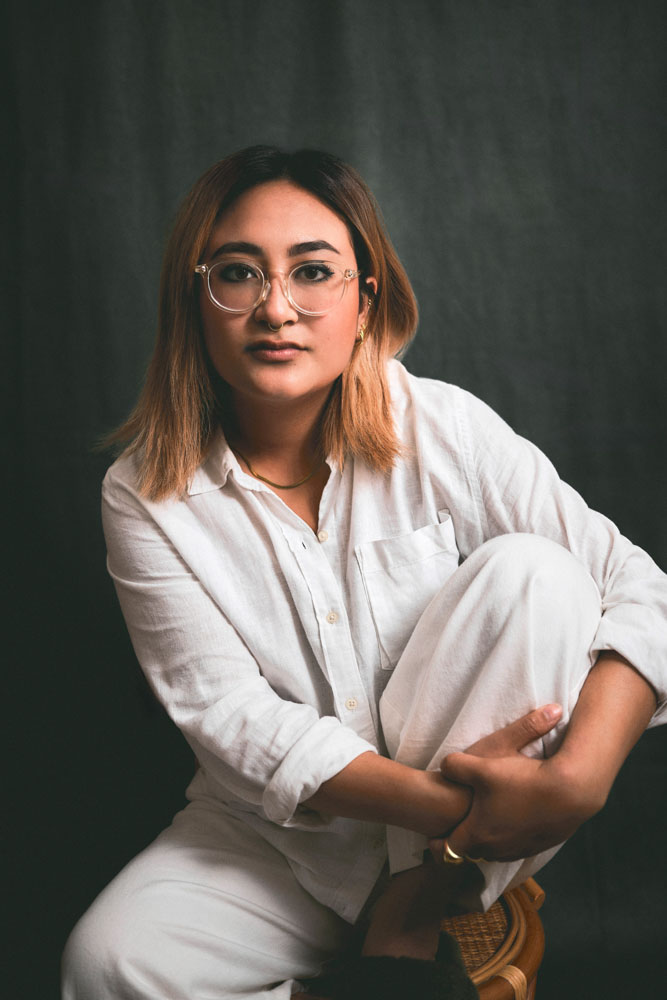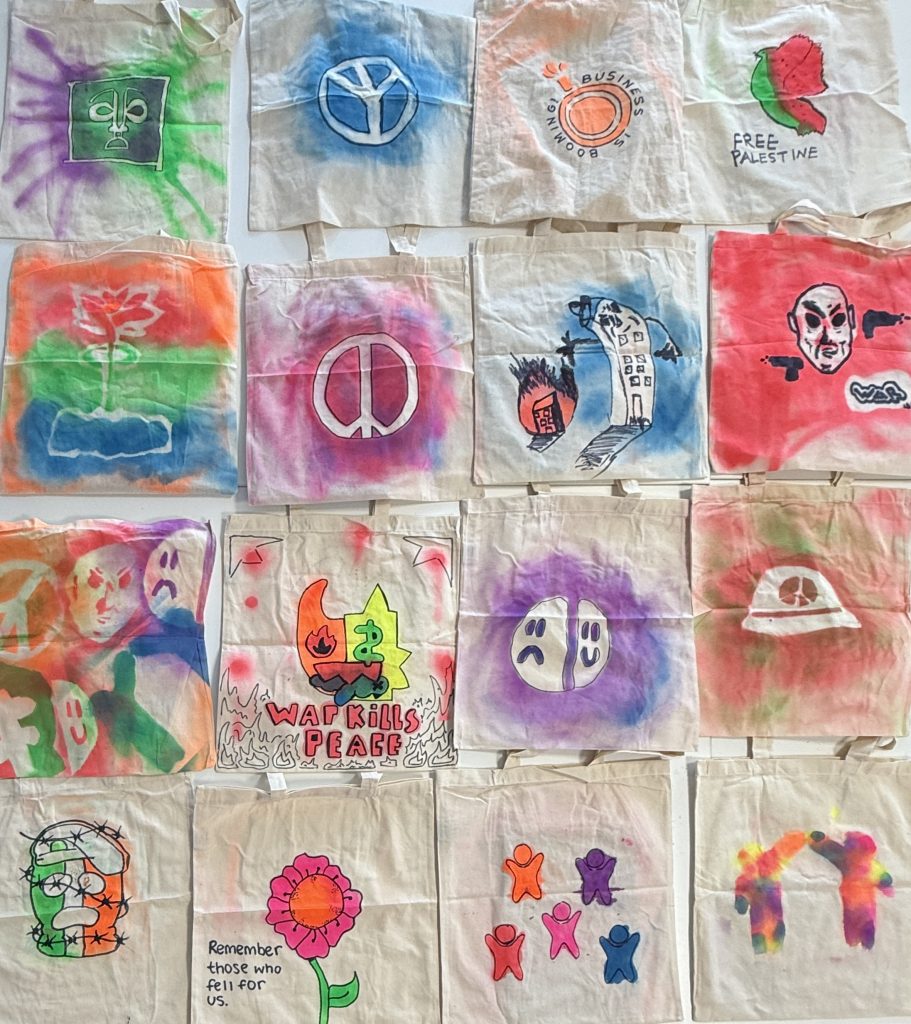Sabby Jamal leads and coordinates the Art&Design Club at Northumbria University. Her background is in Fine Art, and she has experience working in schools, hospitals, and mental health environments using art as a tool for self-expression and well-being.
Tell us about your Club and your approach to programme planning and curriculum development.
My approach to the Club is deeply rooted in using creativity as a means of self-expression, confidence-building, and overall well-being. I take a fluid, child-led approach to programme planning, ensuring it is always person-centred. I often reflect on what I would have wanted growing up – what opportunities and experiences would have been meaningful to me and incorporate those ideas into the curriculum.
I start each year with icebreakers and group activities to help the young people get to know each other. One of my key methods is a ‘post-it note exercise’ where Club members write down their interests and aspirations for the Club. This helps me shape a programme that reflects their needs and desires. I also use weekly feedback, where Club members anonymously rate sessions and share their thoughts through simple symbols like smiley faces or written comments. This allows me to adjust and refine the sessions to ensure they remain engaging and beneficial.
I also focus on individual needs – if someone struggles with a particular skill, I design activities to help them build confidence and comfort in that area. I want them to explore what genuinely excites them, to learn in an engaging and free way, and to leave each session having discovered something new. Whether it’s screen printing or working with clay, I love seeing their excitement when they try something for the first time.
My varied experiences, from working in an outdoor learning school to a mental health hospital, have shaped how I design sessions. In the outdoor school, I saw children freely exploring creativity, which helped me let go of rigid structures. Meanwhile, working in mental health reinforced the importance of well-being and self-expression. These perspectives influence how I encourage Club members to experiment, push their boundaries, and still maintain their individuality.
I also introduce young people to a variety of creative careers by inviting local artists, technicians, and professionals to share their experiences. This exposure helps them see different career paths and inspires them to think about their future in the creative industry. Over time, I’ve learnt to embrace the creative process rather than just focusing on the outcome, and this has led to incredible moments where young people surprise themselves with what they create.
How you incorporate the local area into your Club programme?
A key part of the programme is connecting young people with local opportunities. I bring in artists who share their journeys – their successes, failures, and the realities of making a living as a creative. These honest conversations are incredibly valuable for the Club members.
I introduce young people to a variety of creative careers by inviting local artists, technicians, and professionals to share their experiences. This exposure helps them see different career paths and inspires them to think about their future in the creative industry. Over time, I’ve learnt to embrace the creative process rather than just focusing on the outcome, and this has led to incredible moments where young people surprise themselves with what they create.
We also organise local trips to galleries and creative spaces to show them what’s available in their area. Many of these experiences are completely free for them, which is crucial in making opportunities accessible to all young people.
With your experience in Art Therapy and mental health, what do you believe are the best ways to support young people in nurturing their well-being?
Each week, I make it a priority to check in with individual Club members. I focus on two or three young people per session, having casual conversations while they work. Rather than just discussing the activity, I ask about their week, their interests, and anything creative they’ve been engaged with. This often leads to deeper discussions and helps build trust. Some Club members, especially quieter ones, may not feel comfortable speaking up in a group setting, so these one-on-one moments are essential in making them feel seen and supported.
Often, simple conversations lead to more significant revelations. It’s a method that helps me understand what they need, both creatively and emotionally, and how I can better support them in their personal and artistic growth.
How do you encourage creative thinking within your Club programme, and do you apply what you do at the Club within your other teaching roles?
One of the most effective ways I’ve found to influence better creative thinking is through random pairings. Each week, I encourage Club members to sit with someone new and work in pairs or small groups. This naturally sparks new ideas and conversations. For example, in one session, they worked together to create paper outfits. Initially, I wasn’t sure how well they’d collaborate, but it led to amazing teamwork and discussions.
Another key aspect is peer feedback. At the end of sessions, Club members leave positive comments on each other’s work using post-it notes. This simple exercise not only boosts confidence but also encourages thoughtful discussion and appreciation for different styles and approaches.
By breaking down social barriers and encouraging experimentation, Club members become more open to taking creative risks and expressing themselves freely.
Can you share some memorable moments or experiences from your role as a Saturday Club tutor?
One of my favourite activities involves covering an entire room with paper – walls, floors, everything – and having Club members wear protective suits while they throw paint everywhere. It’s chaotic, messy, and incredibly fun. Activities like this help them let their guard down, embrace playfulness, and see art in a completely different way.
Another highlight is the National Saturday Club Summer Show and Graduation Ceremony. Seeing the young people beam with pride as they showcase their work, take photos, and celebrate their achievements is an indescribable feeling. The transformation in their confidence from when they first join to when they complete the programme is remarkable.
Why did you decide to join the National Saturday Club Tutors’ Advisory Group?
I joined the Tutors’ Advisory Group because I wanted to learn from other educators, exchange ideas, and gain insights into different teaching methods. It’s a space for open conversation, where we discuss challenges, successes, and ways to improve. Learning from others has been incredibly enriching and has helped me develop my approach even further.
What do you see as the key impacts of the Saturday Club on the young people who take part?
The impact of the Club extends far beyond the sessions. I’ve seen students gain confidence, engage more, and even pursue further education in the arts. Some have come back for portfolio support, while others have been inspired to take creative subjects at college. The feedback we receive from past Club members is heartwarming; many say the Club was one of the best experiences of their lives.
One of the most meaningful exercises we did was asking former Club members to write letters to future participants. Their words reflected just how much the Club meant to them, and many expressed sadness at leaving. It’s a testament to the lasting impact the experience has on them.
What do you personally enjoy most about being part of the National Saturday Club and what have you learned from being part of the wider Saturday Club tutors’ network?
What I enjoy most is meeting young people from diverse backgrounds and seeing their unique approaches to creativity. Their excitement to return each week is incredibly rewarding, some even ask if it’s running during holidays because they don’t want to miss out!
In a time when the creative industry can feel uncertain, their enthusiasm reassures me that creativity is alive and thriving. Providing them with opportunities, experiences, and trips they might not otherwise have access to is a privilege. Seeing them discover new passions, build confidence, and develop a love for creativity is what makes being part of the Saturday Club so special.



Interview conducted and edited by Suprina Thapa